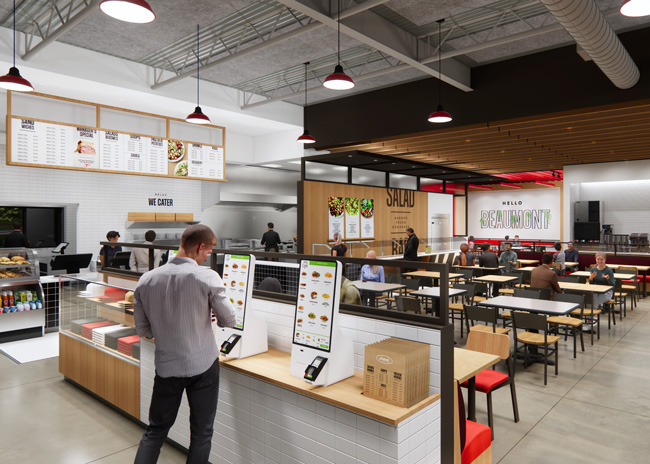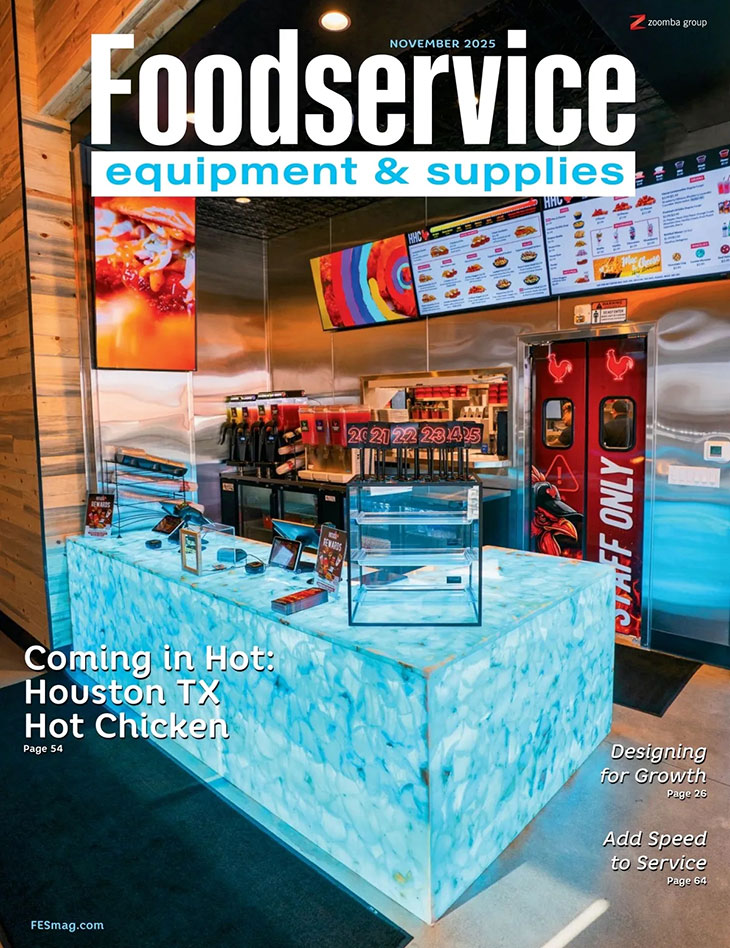How is return to office impacting restaurants? What’s new at Jason’s Deli? How did Chili’s become America’s favorite restaurant? Plus, a breakdown of how proposed tariffs might impact foodservice operators and the industry’s supply chain.
As part of a brand refresh, Jason’s Deli has unveiled a new restaurant design.
An updated salad bar takes center stage in the new design, which was developed in partnership with experience agency ChangeUp. One of the chain’s more popular features, the salad bar now has a larger visual presence in the restaurant. It provides a backdrop to the dining area, with graphic panels that give salad suggestions and encourage customers to craft their own salads.
The chain updated the dining room, too. The space has diversified seating options, moving away from the previous cafeteria feel. This includes the addition of a focal wall to create a more secluded seating zone.
The brightly lit space features touches of warmth through such design elements as seating and wood ceiling elements. In-store messaging communicates the chain’s brand promise. This includes framing the kitchen with a “made by folks who care” message on a glass partition. And a large “honest to goodness food” message wrapping the walls in the dining room.
 Jason’s Deli unveils a new store design. Rendering courtesy of Jason's Deli
Jason’s Deli unveils a new store design. Rendering courtesy of Jason's Deli
Tariff Update
Despite a 30-day pause on potential tariffs that were set to be imposed on Canada and Mexico, expect the topic to remain top of mind foodservice operators and the industry’s supply chain.
A Restaurant Business story explores the reasoning for engaging Mexico and Canada in such a way and how it could impact restaurants. A blog from tech company Touchbistro outlined five ways tariffs could impact restaurants, including higher inventory costs. Operators could choose to absorb those costs, which would eat into their already thin margins, or raise prices, which could cost them customers.
In anticipation of the tariffs, the National Restaurant Association’s economist did an assessment that looks at the most imported food and beverage items. “In this rapidly changing landscape, small business restaurant operators are assessing how they will be impacted, so they can manage pricing pressures, secure key ingredients, and make potential menu adjustments—all while continuing to serve their communities,” said Michelle Korsmo, the NRA president and CEO.
Dealing with tariffs is nothing new for foodservice equipment and supplies manufacturers. In 2018, manufacturers and their supply chain partners had to come to grips with higher prices for aluminum and stainless steel due to tariffs imposed during the first Trump administration.
Foodservice News
- Multiconcept operator Dine Brands laid off about 9% of its staff across different departments, brand teams and offices, per Restaurant Dive. The parent company of Applebee’s, IHOP and Fuzzy’s Taco Shop took this step as part of a “strategic plan to better align with current market conditions,” per a spokesperson. Through the first three quarters of its 2024 fiscal year, Dine Brands’ saw a decline in same-store sales for all three chains mentioned here.
- Contract feeder Whitsons Culinary Group bought Glendale Dining Services. Glendale provides contracted services for senior living and long-term care communities spread across 50 New England locations. The company provides fresh food prepared onsite while managing food sourcing, menu creation and food safety. Glendale has more than 400 team members, per a release.
- How are return-to-office plans impacting restaurants? Data from Placer.ai shows that office visits in 2024 were 34.3% less than pre-COVID levels but 10% greater than in 2023. In 2024, 24.6% of weekday office visits took place on Tuesdays, making it the busiest day of the week. Fridays accounted for just 12.3% of visits. As more people come back to the office visits to coffee shops and fast-casual restaurants are on the rise, per Placer.ai. Both Dunkin’ and Starbucks saw an increase in visits from guests who then proceeded to work. The same applies to fast-casual chains Chipotle, Jersey Mike’s Subs, Panda Express and Five Guys.
- How did Chili’s become America’s hottest restaurant? Same-store sales grow by 31% for the company’s second fiscal quarter of 2025. This was the chain’s third straight quarter of double-digit sales growth. While prices were up, the same applies to customer traffic which increased 20% last quarter. What gives? The chain’s growth is attributed to enhanced french fry and chicken tender recipes, value meals and even a strong social media presence, per a CNN story.
- What’s up next for Starbucks? Menu simplification. The chain may reduce its menu items by as much as 30% per various published reports, including this one from Fortune. Doing so will give Starbucks flexibility to provide different food and drink experiences during the morning and afternoon dayparts. Doing so will allow the chain to better “reflect the coffeehouse feel.” These efforts will include greater use of digital menu boards.
- As traditional foodservice equipment becomes more streamlined and higher-tech, the same can be said of some robotics options. The makers of Flippy, the burger-flipping robot, have used AI and other technology to make the units smaller and easier to clean, per The Robot Report.
- If it seems like consumers were paying more for their restaurant/foodservice meals last year that’s only because they were. Data from research firm Technomic says consumer foodservice prices increased by 4.1% in 2024. The good news was that the 2024 increase was less than the 7.7% increase from 2022 and the 7.1% increase from 2023.
- Can an ice cream buffet withstand the Las Vegas heat? The Museum of Ice Cream believes that to be the case and plans to open a 30,000-square-foot facility featuring an ice cream buffet by 2026, per Eater Las Vegas. Embracing the Las Vegas vibe, this facility plans to have an ice cream cake wedding chapel, a pink party bus and an oversized sprinkle pool.
- Organizers of the National Restaurant Association Show in Chicago have launched a scholarship for young professionals wanting to attend the event, which takes place in Chicago in May. Foodservice operators or hospitality students between the ages of 21 and 35 years old as of May 17, 2025, are eligible to participate.
- Softer customer traffic and same-store sales readings led to a slight dip in the National Restaurant Association’s Restaurant Performance Index in December. The RPI came in at 100.1 in December, down from 101.2 the previous month.
- Chuck E. Cheese gets in on the Super Bowl fun. Super Bowl bets are typical amongst friends or even politicians from the participating cities. Now management of the Kansas City and Philadelphia Chuck E. Cheese restaurants have made a friendly wager. If the Eagles win, Kansas City locations will be temporarily renamed to “Chuck ‘Eagles’ Cheese,” but if the Chiefs win, Philly locations will be called “Chuck E. Chiefs,” as WPHL reports.
Economic News
- Consumers continued to feel the impact of inflation in December, per the latest data from the U.S. Bureau of Economic Analysis. Disposable personal income increased only 0.4%, while personal consumption expenditures grew by 0.7%.
- Real gross domestic product increased 2.3% during the fourth quarter of 2024, per the U.S. Bureau of Economic Analysis. This was less than the third quarter growth rate of 3.1% and it’s also lower than the 2.5% economists polled by Dow Jones had projected, per a CNBC story.
- The number of job openings decreased to 7.6 million on the last business day of December, the U.S. Bureau of Labor Statistics reported. This beat economists' projections which had called for 8.0 million job openings for December, per an Investing.com story. November job openings totaled 8.1 million. December’s hires and total separations were little changed at 5.5 million and 5.3 million, respectively. In November, hires came in at 5.3 million and separations totaled 5.1 million.
- Employment costs increased 0.9% for the 3-month period ending in December 2024, the U.S. Bureau of Labor Statistics reported. Wages and salaries increased 0.9% and benefit costs increased 0.8% from September 2024. This was in line with what economists had projected, per a Yahoo! Finance story. Compensation costs for civilian workers increased 3.8% percent for the 12-month period ending in December 2024 and increased by 4.2% in December 2023.
- Initial jobless claims declined by 16,000 resulting in a total of 207,000 for the week ending January 25, 2025, per the U.S. Department of Labor. Economists polled by Reuters had projected claims would total 220,000. The more stable 4-week moving average was 212,500 claims, a decrease of 1,000 from the previous week.
- New orders for manufactured goods decreased 0.9% in December, the U.S. Census Bureau reported. This followed a 0.8% November decrease and was greater than economists projections of a 0.7% decline. Shipments, up two consecutive months, increased 0.6%.



